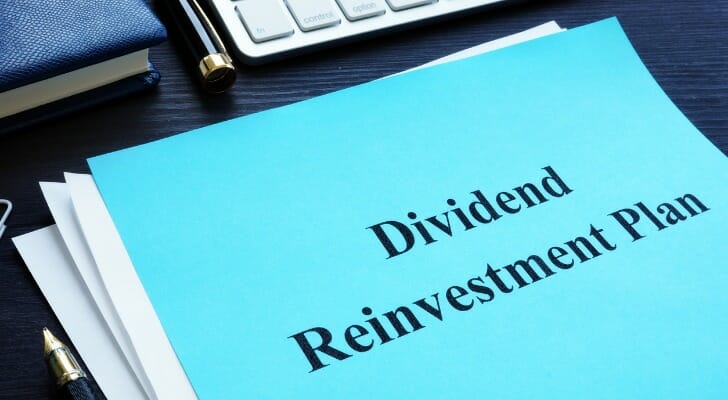
A dividend reinvestment plan, or DRIP, is a vehicle that reinvests the money shareholders get from companies in cash dividends. Many investors favor DRIPs because of their ease, low-to-nonexistent fees and ability to strengthen returns over a long time horizon. By supplying shareholders with an automated way to reinvest their money, it also takes away the temptation of spending those cash dividends irresponsibly. Read on to learn more about DRIPs, including the different types, their pros and cons and how to enroll in one.
A financial advisor can help you create a financial plan for your investing needs and goals.
What Are Dividends?
To grasp the concept of dividend reinvestment plans (DRIPs), you should first understand what dividends are. Dividends are a portion of a company’s profits that are paid out to shareholders. Not all companies offer dividends, though. This is because the distribution of dividends traditionally only occurs after a company has both covered its expenses and made reinvestments in its own business. Growing companies often can’t afford to pay dividends, so larger, established companies are more likely to provide them.
Dividends come in two variations: cash dividends and stock dividends. Cash dividends are the more common of the two. Rather than pay a flat amount, companies issue cash dividends on a per-share basis. By contrast, stock dividends are given out as an overall percentage based boost to your total shares. Here’s a rundown of each:
Examples of Cash & Stock Dividends
| Type of Dividend | Your Total Shares | Dividend Payment/Growth | What You Receive |
| Cash Dividend | 80 shares | 35¢ per share | $28 |
| Stock Dividend | 50 shares | 10% | 5 shares (55 total) |
What Is a Dividend Reinvestment Plan?
Dividend reinvestment plans automatically reinvest the quarterly cash dividends shareholders receive in exchange for more equity. This means that instead of receiving your dividends as a check or direct deposit, they’ll be put toward the purchase of more stocks in the same company. There are rarely excess fees associated with DRIPs. That makes them a cost-effective alternative to manual investments. Note that although DRIPs are commonly associated with equities, you can also gain exposure to them in conjunction with exchange-traded funds (ETFs) and mutual funds.
DRIPs exist in the following forms:
- Company DRIPs. Businesses create their own dividend reinvestment plans. Because companies directly manage these DRIPs, they are best-suited for investors looking to trade in individual stocks. On top of this, many companies will offer discounts on shares for anyone enrolled in their DRIP. Not all companies have proprietary DRIPs, though, as fewer than 1,000 companies currently on U.S. stock exchanges boast such a plan. Many times, companies will hire an outside firm, otherwise known as a transfer agent, to handle its DRIP.
- Brokerage DRIPs. Brokerage firms, like TD Ameritrade and Merrill Edge, allow investors to take advantage of DRIPs directly through them. Unlike company plans, clients of online brokerages gain access to DRIPs for ETFs, mutual funds and stocks. Brokerages will often let you select between enrolling in DRIPs for all of your eligible investments or solely for specific ones.
There’s a long-standing debate between whether investing in a DRIP through a company or brokerage is better. Company-based DRIPs offer some significant perks that brokerages can’t match. These include up to 10% discounts on reinvestments, cheaper fees and no commissions. These DRIPs also allow shareholders to buy fractions of stocks if their cash dividends can’t fully cover a share, something brokerages can’t deliver.
Alternatively, brokerage-based plans let investors get their hands on a wide variety of DRIPs for stocks, ETFs and mutual funds alike. For risk-averse investors, this could be an especially important benefit, as mutual funds and ETFs feature inherent diversification and professional management. While you may spend more in trading fees, a brokerage account enables you to see all of your investments and DRIPs in one place.
Pros and Cons of Dividend Reinvestment Plans

Over the long-term, using a DRIP could increase your investment returns by a sizable margin due to compounding interest. This makes DRIPs particularly attractive for younger investors, as they are less likely to have an immediate need for cash income. Moreover, if you invest through a company DRIP, you’ll encounter minimal fees. In the end, this will keep more money in your portfolio.
Most Americans have enough going on in their life that investing can easily fall on the back burner. If this is the case for you, the simplicity of a DRIP should sound enticing. Your cash dividends will continue to be reinvested. Whenever you’re ready to sell, just cancel your enrollment in the DRIP.
On the flip side, the ease of DRIPs might give some people anxiety. The fundamental loss of autonomy that these plans induce could leave DIY investors worrying about a lack of control. Plus, just because you’re invested in a stock, mutual fund or ETF doesn’t mean you necessarily want to keep pouring your assets into it.
As you now know, DRIPs automatically reinvest your cash dividends. But even though you technically never see that money, it’s still taxable income, so you must report it. However, dividends frequently receive a qualified status, meaning you’ll pay taxes at a lower rate than ordinary income.
While DRIPs are perfect for saving for retirement, retirees usually steer clear of them. Rather than reinvest the cash dividends they receive, retirees use them as additional income. In fact, some individuals even build cash dividend schedules so they receive payments at regular times throughout the year.
How to Enroll in a DRIP
Prior to enrolling in a DRIP, you’ll need to be an existing shareholder. This generally means that you must own at least one share of the applicable stock, mutual fund or ETF. Each company will specify how long you must remain a shareholder before accessing its DRIP, so be sure to pay close attention to that.
Once you’re eligible, the easiest way to enroll in a DRIP is to go through a brokerage. Brokers customarily offer access to DRIPs right through their online platforms. Something to look out for: if you’re investing via a broker, make sure the shares are in your name rather than the firm’s. If not, you may loss eligibility for the DRIP.
If you’d rather bypass the brokerage route, prospective investors can enroll through a company’s transfer agent. Generally speaking, you’ll need to visit the company’s website and visit its section devoted to investor relations. From here, you’ll go through the step-by-step process of enrolling in its DRIP.
Tips for Getting into Investing

- If you’re apprehensive about starting an investment portfolio on your own, financial advisors can walk you through the process. SmartAsset’s free tool matches you with up to three vetted financial advisors who serve your area, and you can interview your advisor matches at no cost to decide which one is right for you. If you’re ready to find an advisor who can help you achieve your financial goals, get started now.
- Are you a fan of a more DIY approach? Opening a brokerage account allows you to invest independently. When you become the client of a brokerage, you’ll have wide access to securities like stocks, ETFs and bonds. Though you’ll encounter brokerage fees, these costs are usually lower than what you’d find at financial advisors.
Photo credit: ©iStock.com/anilakkus, ©iStock.com/designer491, ©iStock.com/Jirapong Manustrong